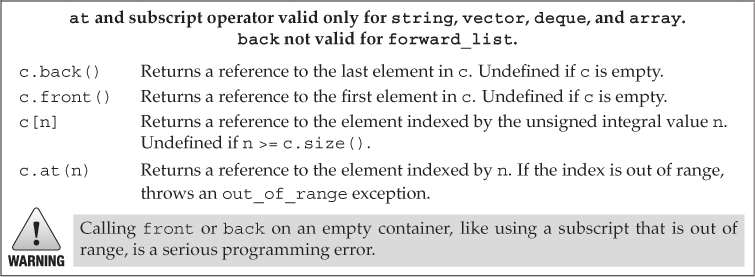9.3.2. Accessing Elements
Table 9.6 lists the operations we can use to access elements in a sequential container. The access operations are undefined if the container has no elements.
Table 9.6. Operations to Access Elements in a Sequential Container

Each sequential container, including array, has a front member, and all except forward_list also have a back member. These operations return a reference to the first and last element, respectively:
// check that there are elements before dereferencing an iterator or calling front or back
if (!c.empty()) {
// val and val2 are copies of the value of the first element in c
auto val = *c.begin(), val2 = c.front();
// val3 and val4 are copies of the of the last element in c
auto last = c.end();
auto val3 = *(--last); // can't decrement forward_list iterators
auto val4 = c.back(); // not supported by forward_list
}
This program obtains references to the first and last elements in c in two different ways. The direct approach is to call front or back. Indirectly, we can obtain a reference to the same element by dereferencing the iterator returned by begin or decrementing and then dereferencing the iterator returned by end.
Two things are noteworthy in this program: The end iterator refers to the (nonexistent) element one past the end of the container. To fetch the last element we must first decrement that iterator. The other important point is that before calling front or back (or dereferencing the iterators from begin or end), we check that c isn’t empty. If the container were empty, the operations inside the if would be undefined.
The Access Members Return References
The members that access elements in a container (i.e., front, back, subscript, and at) return references. If the container is a const object, the return is a reference to const. If the container is not const, the return is an ordinary reference that we can use to change the value of the fetched element:
if (!c.empty()) {
c.front() = 42; // assigns 42 to the first element in c
auto &v = c.back(); // get a reference to the last element
v = 1024; // changes the element in c
auto v2 = c.back(); // v2 is not a reference; it's a copy of c.back()
v2 = 0; // no change to the element in c
}
As usual, if we use auto to store the return from one of these functions and we want to use that variable to change the element, we must remember to define our variable as a reference type.
Subscripting and Safe Random Access
The containers that provide fast random access (string, vector, deque, and array) also provide the subscript operator (§ 3.3.3, p. 102). As we’ve seen, the subscript operator takes an index and returns a reference to the element at that position in the container. The index must be “in range,” (i.e., greater than or equal to 0 and less than the size of the container). It is up to the program to ensure that the index is valid; the subscript operator does not check whether the index is in range. Using an out-of-range value for an index is a serious programming error, but one that the compiler will not detect.
If we want to ensure that our index is valid, we can use the at member instead. The at member acts like the subscript operator, but if the index is invalid, at throws an out_of_range exception (§ 5.6, p. 193):
vector<string> svec; // empty vector
cout << svec[0]; // run-time error: there are no elements in svec!
cout << svec.at(0); // throws an out_of_range exception
Exercises Section 9.3.2
Exercise 9.23: In the first program in this section on page 346, what would the values of val, val2, val3, and val4 be if c.size() is 1?
Exercise 9.24: Write a program that fetches the first element in a vector using at, the subscript operator, front, and begin. Test your program on an empty vector.
